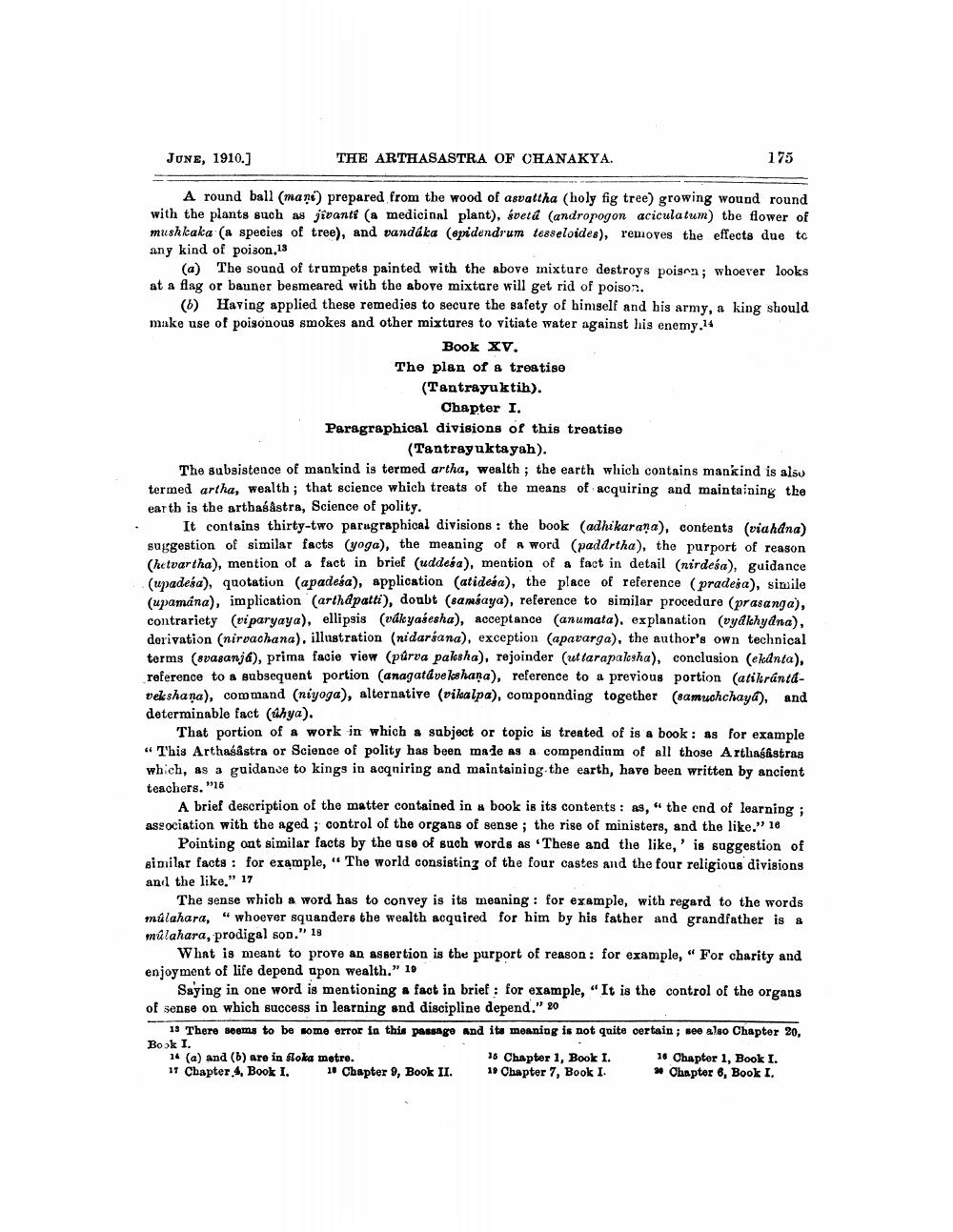________________
JUNE, 1910.)
THE ARTHASASTRA OF CHANAKYA.
175
A round ball (man) prepared from the wood of asvattha (holy fig tree) growing wound round with the plants such as jivanti (a medicinal plant), sveta (andropogon aciculatum) the flower of mushkaka (a species of tree), and vandáka (epidendrum te88eloides), removes the effects due to any kind of poison,13
(a) The sound of trumpets painted with the above mixture destroys poison; whoever looks at a flag or banner besmeared with the above mixture will get rid of poison.
(6) Having applied these remedies to secure the safety of himself and his army, a king should make use of poisonous smokes and other mixtures to vitiate water against his enemy.14
Book xv. The plan of a treatise (Tantrayuktih).
Chapter I. Paragraphical divisions of this treatise
(Tantrayukta yah). The subsistence of mankind is termed artha, wealth ; the earth which contains mankind is also termed artha, wealth; that science which treats of the means of acquiring and maintaining the earth is the arthasastra, Science of polity.
It contains thirty-two paragraphical divisions : the book (adhikarana), contents (viahana) suggestion of similar facts (yoga), the meaning of a word (padartha), the purport of reason (hetvartha), mention of a fact in brief (uddesa), mention of a fact in detail (nirdesa), guidance (upadesa), quotation (apadesa), application (atideáa), the place of reference (pradesa), simile (upamana), implication (arthápatti), doubt (samsaya), reference to similar procedure (prasanga), contrariety (vi paryaya), ellipsis (vákyasesha), acceptance (anumata), explanation (uydichyana), derivation (nirvachana), illustration (nidarsana), exception (apavarga), the author's own technical terms (spasanja), prima facie view (půrva paksha), rejoinder (uttarapalesha), conclusion (ekanta), reference to a subsequent portion (anagatdvekshana), reference to a previous portion (atikrántávekshana), command (niyoga), alternative (vikalpa), compounding together (samuchchayd), and determinable fact (thya).
That portion of a work in which a subject or topic is treated of is a book : as for example "This Arthasastra or Science of polity has been made as a compendium of all those Artlasastras which, as a guidance to kings in acqniring and maintaining the earth, have been written by ancient teachers. "16
A brief description of the matter contained in a book is its contents: As," the end of learning ; association with the aged ; control of the organs of senge ; the rise of ministers, and the like." 10
Pointing ont similar facts by the use of such words as These and the like,' is suggestion of similar facts : for example, " The world consisting of the four castes and the four religious divisions anıl the like." 17
The sense which a word has to convey is its meaning: for example, with regard to the words múlahara, “whoever squanders the wealth acquired for him by his father and grandfather is a mülahara, prodigal sop.” 19
What is meant to prove an assertion is the purport of reason: for example, "For charity and enjoyment of life depend upon wealth." 10
Saying in one word is mentioning a fact in brief : for example, "It is the control of the organs of sense on which success in learning and discipline depend." 20
13 There seems to be some error in this passage and its meaning is not quite certain ; see also Chapter 20, Book I. 16 (a) and (b) are in sloka metre.
16 Chapter 1, Book I. 16 Chapter 1, Book I. 11 Chapter 4. Book I. 11 Chapter 9, Book II. 19 Chapter 7, Book I. * Chapter 6, Book I.




